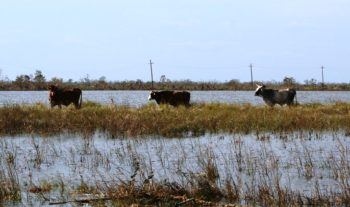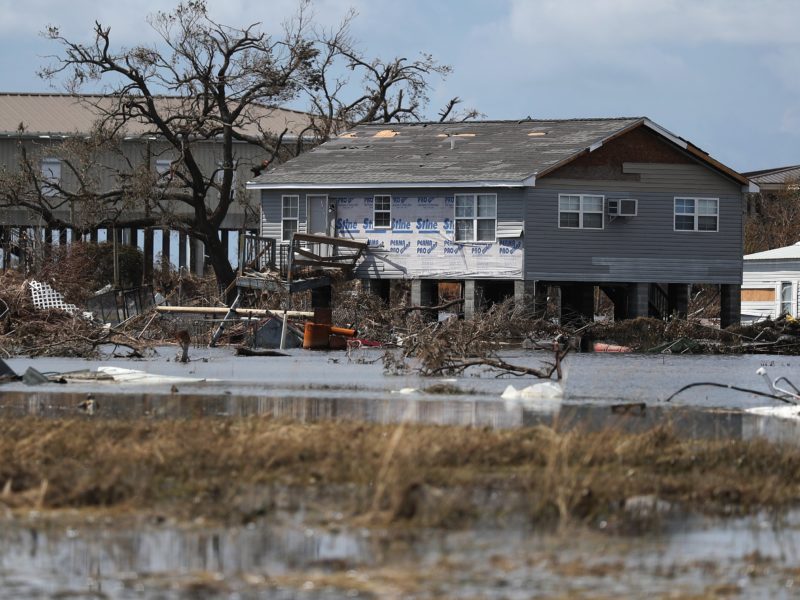AgriLife Extension Helps Before, After Hurricane Laura

In advance of Hurricane Laura reaching landfall and in its immediate aftermath, the Texas A&M AgriLife Extension Service has been providing information and assistance to Texans affected by the disaster.
Monty Dozier, head of the agency’s Disaster Assessment and Recovery, or DAR, unit, said agents in the affected counties have been helping residents prepare for the disaster, and additional people and resources are on their way.
Disaster Assessment and Recovery (DAR) team efforts
“We have an agent assisting at the Houston District Disaster and Emergency Operations Center, and others will be placed to help support other emergency operations centers as requested in the coming days,” he said. “Some agents have already been tasked to work in county emergency operations centers.”
He said agents have also been providing guidance to livestock owners and will be assisting with feed and recovery efforts from catastrophic flooding and other effects of the storm.
Additional support efforts included DAR agents in the Houston area making personal protective equipment deliveries to 26 assisted living facilities that were evacuating residents, Dozier said. In addition, a truckload of personal protective equipment was delivered by DAR team members to the Ford Park staging area in Beaumont as supplies for responders and for the animal supply point being set up there.
“We will be deploying four DAR agents and two AgriLife Extension county agents to support the TAMU Veterinary Emergency Team and the Texas Animal Health Commission (TAHC) with animal sheltering and supply point operations at Ford Park in Jefferson County,” he said. “As of today, this is the only shelter and animal supply point that has been established, but we expect there may be others set up over the next few days, depending upon need.”
DAR team members are also on standby to assist Texas Division of Emergency Management, TDEM, with the distribution of personal protective equipment and other supplies to first responders, government entities, assisted living facilities and communities.
Animal sheltering and recovery
AgriLife Extension is monitoring the status of evacuation hubs for people and animals with the Texas Animal Health Commission. It also stands ready to support TDEM and local jurisdictions in Southeast Texas to provide assistance with sheltering and post-storm damage assessments.
Rachel Bauer, AgriLife Extension program specialist and agency liaison with TDEM, said at this time there are only a few active locations where animals can be evacuated for sheltering from Hurricane Laura.
“A large animal-only sheltering site has already been set up in Bryan at the Brazos County Expo Center,” she said. “In the affected area, the Montgomery County Fairgrounds will accept horses and 4-H/FFA livestock projects only.”
Additional shelter sites in Chambers and Jefferson counties also have been identified and are on standby until more information is available.
Bauer said the TAHC is in the process of compiling a list of locations where livestock and other animals may be sheltered. The information will also be uploaded and available on the Texas 211 website. More updates and information on managing animals during a disaster can also be found on the TAHC and Texas Extension Disaster Education Network websites.
Helpful information on disaster preparation and recovery
Dozier said that while Hurricane Laura was still a tropical storm the agency made efforts through the news and social media to advise area residents of the variety of emergency disaster preparation materials available through the agency. It also advised them of the importance of having well water checked for contamination if flooded.
“Texas Extension Disaster Education Network and the Texas A&M AgriLife Bookstore* have an array of materials not only related to disaster preparation, but also disaster recovery,” he said.
Dozier noted some of the materials related to flood recovery include those related to emergency food and water supplies, cleaning flood-damaged homes, dry-out before rebuilding, electrical power outages, post-flood safety, protecting and replacing personal documents, mold removal and repairing a flood-damaged home.
He also noted the e-book “After a Disaster: Information to Help You and Your Family Recover” contains information on various recovery-related topics such as assessing structural damage, debris removal, basic first aid, removing odors and salvaging important documents. In addition to downloading the entire guide in the e-book format, users may also download the complete guide or specific sections in PDF format.
Dozier said once the extent of damage caused by Hurricane Laura has been determined, additional AgriLife Extension agents and members of the DAR team will be sent to and remain in the affected area for as long as help is needed.
“We’re here to help Texans affected by this disaster to recover,” Dozier said. “We’ve got a lot of experience in reacting to emergencies and disasters throughout the state, as well as a statewide network of agents, specialists and others to draw support from for our disaster recovery efforts. We’re glad to be here for those affected by Hurricane Laura.”
* This link is no longer active and has been removed.
This article by Paul Schattenberg originally appeared on AgriLife Today.




